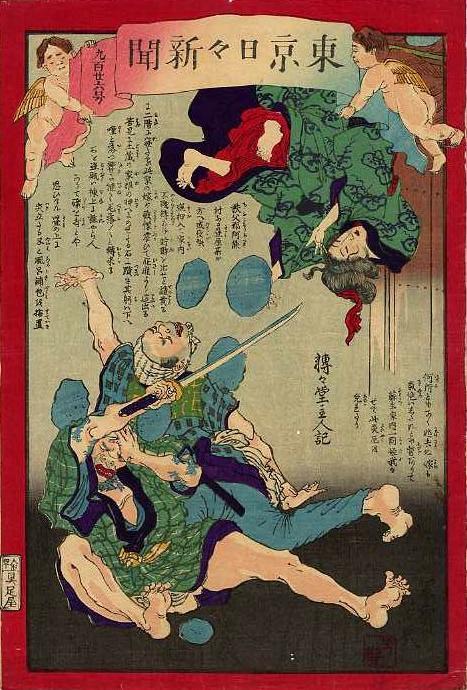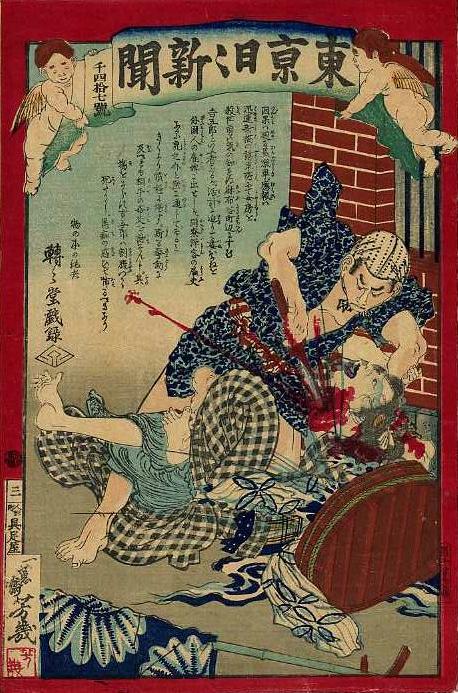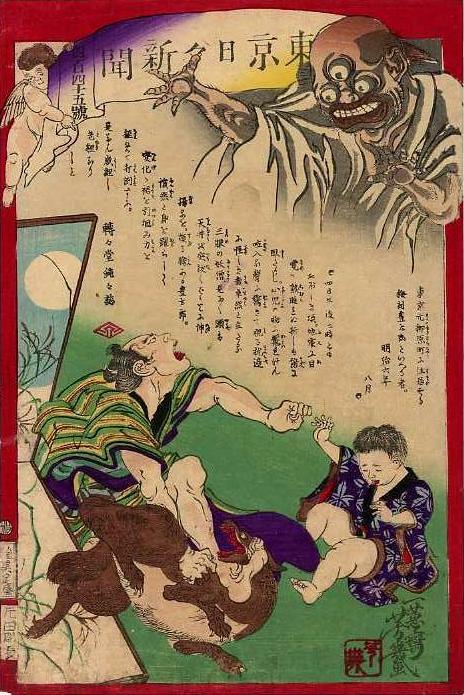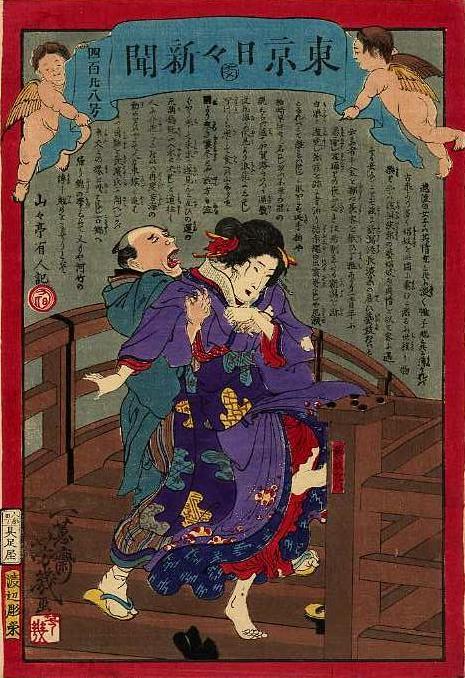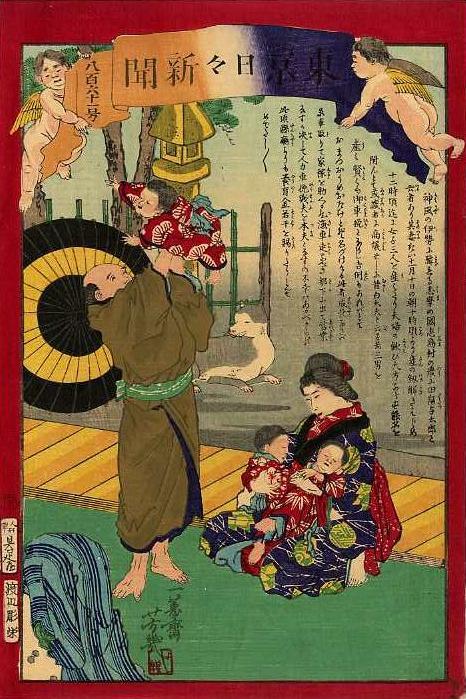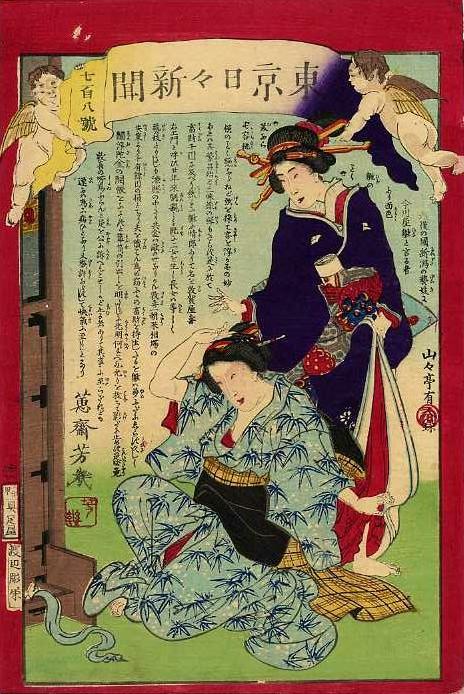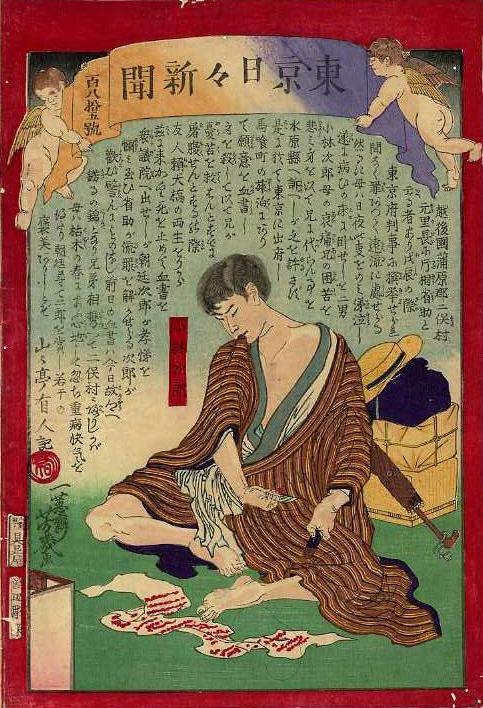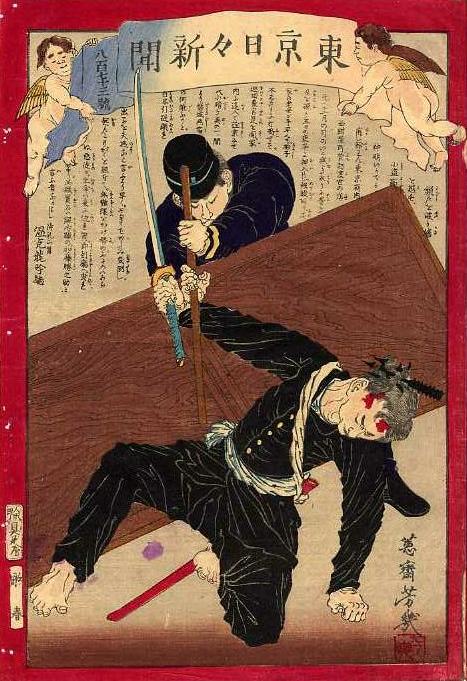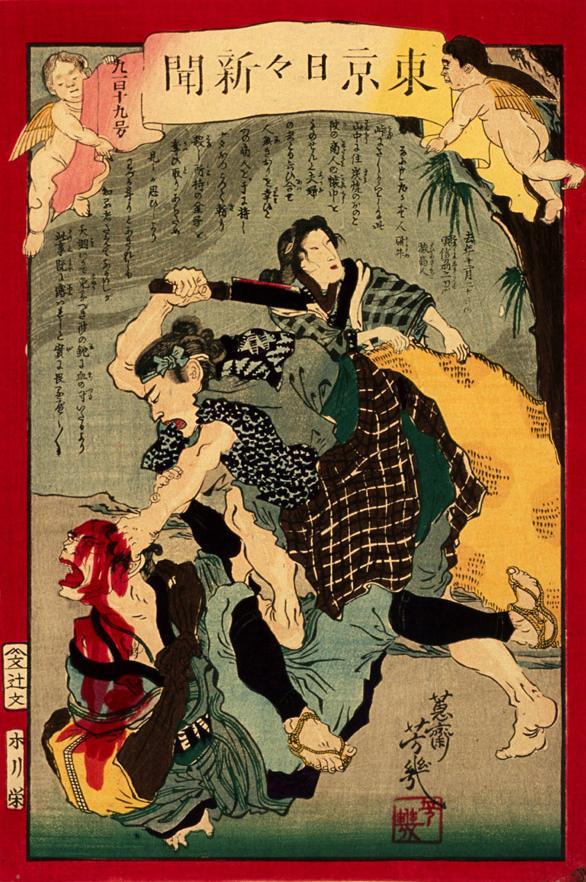TNS news nishikie
Print variations
By William Wetherall
First posted 1 December 2007
Last updated 1 February 2010
TNS variations Banner colors | Publisher/carver cartouches | Picture colors | Pictures and stories | Minor details | Tsujibun reissues
TNS variations
All issues of the main TNS news nishikie series were printed in from several to many runs of perhaps two hundred sheets each.
After a print run, the blocks would be washed and dried. This could warp the blocks and/or damage finer details. Consequently, later impressions tend to have poorer registration from warping and degraded resolution of hair and the like from wear. The worst impressions might show evidence of gross damage like chipping or splitting of ridges.
Before a new print run, pigment pots would be replenished from stock, or new preparations would be made. This could result in slightly different hues.
In addition to such wear-and-tear and minor pigment variations, which were common to all wood-block publications, many issues of TNS were reprinted with somewhat different color schemes. Several issues, originally published by Gusokuya, were later republished by Tsujibun.
Types of variations
Here I will focus on printing variations within issues, rather than on stylistic differences between issues. See other TNS articles for observations of differences in banner and cherub styles, among other features that varied according to stage or issue.
The most conspicuous variations are seen in the pigments used to color the ends of the unfurled banners. A less noticeable variation is the background color of the publisher and carver cartouches -- particularly of the carver cartouche.
Some issues have editions in which some backgrounds, foregrounds, or objects in the picture are colored with notably different pigments. And a few issues have editions that show minor changes in detail, and a later edition of one issue reflects major changes to the original picture and story.
Fading and other forms of change
Apparent variations in coloring may reflect degrees of fading or other changes in the original colors over the years, rather than a use of different pigments at the time the print was made.
See Exposure effects on color for examples of and discussions of how exposure to light and other elements over time may effect the colors of pigments.
| Picture colors | |
|
A number of prints show conspicuous color-scheme variations. |
|
Lavender and purple dovesTNS-832 has several striking variations that play with the colors of the doves. |
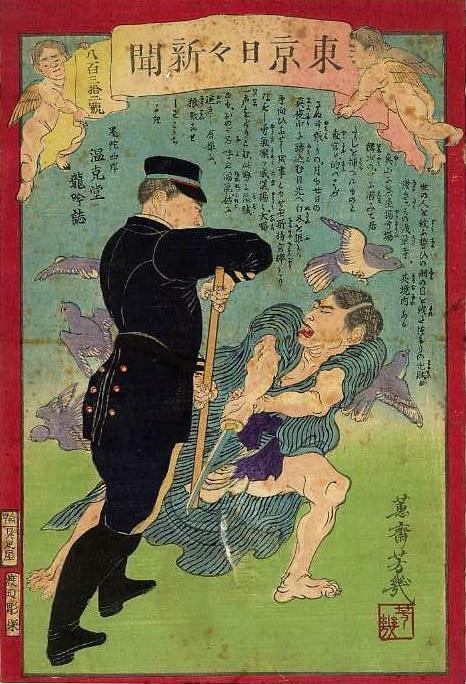
|
Tsujibun reissues
Sato Kenji, in "Nyuusu to iu monogatari" [The story of news] in Nyuusu no tanjo [The birth of news] (Kinoshita and Yoshimi 1999:204-237), imputes the following significance to the Tsujibun editions (page 214, my translation).
|
Among the news nishikie that took material in "Tokyo nichinichi shinbun" [the newspaper] are those that were put out from another publisher using the exact same edition. The details are unclear, but those that were sold and succeeded as commodities at Gusokuya, were probably those that were bought blocks and all and sold by Tsujibun. This point, too, is somewhat different from the publishing system of the recent [early modern] period. As for Tokyo nichinichi shinbun news nishikie for which there are editions from Tsujibun, more than a few have been confirmed. Their existence narrates a commodity quality as a nishikie, which differs from the newspaper itself, which values promptness and regularity. |
Sato's view is substantiated by the fact that most of the "more than a few" known Tsujibun editions boast very souvenirish designs and stories.
Tomizawa Tatsuzo pans Sato's view that news nishikie were more closely affiliated with "nishikie" than with "news" (CCMA 2008:4-5). He adopts Tsuchiya Reiko's view that news nishikie were primarily "news" media.
However, Tomizawa made no attempt to test Tsuchiya's hypothesis. He entirely relies on the opinions of others who have similarly failed to examine the prints themselves in order to better illuminate their essentially "souvenir" quality.
Tellingly, Tomizawa's cavalier treatment of the Tsujibun editions (CCMA 2008:9, note 8) explains why the print edition data reported in the Chiba City Museum of Art publication is so flawed (see Bibliography).
Most puzzling, though, is that the article in which Sato made the foregoing observation was immediately preceded by a shorter article by Tomizawa called "Nishikie no nyuusu-sei" [The news quality of nishikie] (Kinoshita and Yoshimi 1999:192-203). Yet in CCMA 2008, Tomizawa credits CCMA's chief curator, Asano Shūgō, for his conjecture Gusokuya probably sold the original TNS blocks to Tsujibun (CCMA 2008:9, note 8).
Table of Tsujibun reissues
As of this writing (October 2008) I know of the existence of 18 Tsujibun editions. All prints are listed in the following table with links to their images and stories on this website.
| Tsujibun TNS reissues | |||
| Issue | Click Title to view | Publication (Collection), [Notation] | |
| 1 | Priest kills woman | Ono (two copies), Takahashi, [CCMA] | |
| 3 | Okinu and Rikaku | Yosha, Takahashi, Newspark | |
| 220 | Treacherous couple | Takahashi | |
| 445 | Three-eyed demon | Takahashi | |
| 689 | Shogitai heroes | Yosha, Takahashi, Tsuchiya (Araya), [CCMA] | |
| 822 | Family of thieves | Ono, Takahashi, [CCMA] | |
| 833 | Cop kills three women | Hagi Uragami Museum | |
| 849 | Showing the flag | Ono, [CCMA] | |
| 865a | Dog finds head | Takahashi | |
| 877 | Poisonous affair | Yosha | |
| 885 | Elderly in jealous spat | Yosha, Ono, Tsuchiya (Nishigaki), [CCMA] | |
| 892 | Woman cuts off lover's nose | CCMA | |
| 911a | Ghost deceives widower | Kanbara, Tsuchiya (Nishigaki), [CCMA] | |
| 919a | Couple murders peddler | Ono, Takahashi, Itabashi-ku (Takahashi), Tsuchiya (Nishigaki), [CCMA] | |
| 923 | Benzo kills Nanigashi | Yosha | |
| 926a | Bride surprises thieves | Yosha | |
| 926b | Chushingura actor shot | Yosha, Tsuchiya (Nishigaki?) | |
| 940b | Strange man under stage | Yosha, Ono, Tsuchiya (Shajoken), [CCMA] | |
| Totals | Source (Collection) | ||
| 1 | Araya Bunko (Mainichi Shinbun) | ||
| 1 | Hagi Uragami Musueum (Yamaguchi Prefecture) | ||
| 1 | Kanbara Bunko (Kagawa University Library) | ||
| 4 | Nishigaki Bunko (Waseda University Library) | ||
| 1 | Shajoken (Ono Collection at Tokyo University) | ||
| 6 | Ono 1972 (Ono Collection) | ||
| 8 | Takahashi 1986 (Takahashi Collection) | ||
| [1] | Itabashi-ku 1988 [1 Takahashi Collection] | ||
| [6] | Tsuchiya 2000 (Bunsei CD-ROM) [4 Nishigaki, 1 Araya, 1 Shajoken] | ||
| 1 | Newspark 2001 (Newspark) | ||
| 8 | Yosha Bunko (News Nishikie, since 2004) | ||
| 1 [8] | CCMA 2008 (Rikken Collection) [Note 1] | ||
|
Note 1 CCMA 2008 has a table in the back that lists all the prints in the book by issue number. The table shows all TNS prints to be Gusokuya prints, but the comment "There is also a Tsujibun (Tsujiokaya Bunsuke) edition" appears in the Remarks column of nine (9) prints. One expects, from the way the table is written, that all the prints in the book will be Gusokuya editions -- and all but one are. The exception is TNS-892 (page 51) -- the only Tsujibun edition print in the book. As this issue is not attributed to another collection, presumably it is part of the Rikken Collection. It is not clear if this collection includes the other issues for which it is remarked that there are also Tsujibun editions. |
|||
